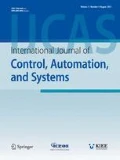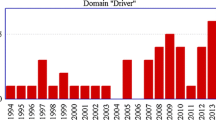Abstract
The study of human behavior during driving is of primary importance for improving the driver’s security. In this study, we propose a hierarchical driver_vehicle_environment fuzzy system to analyze driver’s behavior under stress conditions on a road. We include climate, road and car conditions in fuzzy modeling. For obtaining fuzzy rules, experts’ opinions are benefited by means of questionnaires on effects of parameters such as climate, road and car conditions on driving capabilities. The number of fuzzy rules is optimized by Particle Swarm Optimization (PSO) algorithm. Also the frequency of pressing on brake and gas pedals and the number of car’s direction changes are used to determine the driver’s behavior under different conditions. Three different positions are considered for driving and decision making; one position in driving lane and two positions in opposite lane. A fuzzy model called Model 1 is presented for modeling the change of steering angle and speed control by considering time distances with existing cars in these three positions, the information about the speed and direction of car, and the steering angle of car. The behaviors of different drivers under two stress conditions are investigated. Also we obtained two other models based on fuzzy rules called Model 2 and Model 3 by using Sugeno fuzzy inference. Model 2 has two linguistic terms and Model 3 has four linguistic terms for estimating the time distances with other cars. The results of three models are compared. The comparative studies have shown that simulation results are in good agreement with the real world situations.
Similar content being viewed by others
References
C. C. MacAdam, “An optimal preview control for linear systems,” Trans. of ASME, vol. 102, no. 3, pp. 188–190, September 1980.
R. E. Fenton, “On the optimal design of an automotive lateral controller,” IEEE Trans. on Vehicular Technology, vol. 37, no. 2, pp. 108–113, 1988.
A. Y. Lee, “Algorithm for four-wheel-steering passenger vehicles,” Journal of Dynamic system, Measurement and Control, vol. 114, pp. 401–407, 1992.
C. C. MacAdam and G. E. Johnson, “Application of elementary neural networks and preview sensors for representing driver steering control behavior,” Vehicle System Dynamics, vol. 25, pp. 3–30, 1996.
P. E. An and C. J. Harris, “An intelligent driver warning system for vehicle collision avoidance,” IEEE Trans. on Systems, Man and Cybernetics, Part A: Syst. and Humans, vol. 26, no. 2, pp. 254–261, 1996.
S. Hoogendoom, S. Hoogendoom-Lanser, and H. Schuurman, “Perspectives of fuzzy logic in traffic engineering,” TRB 78th Annual Meeting, USA, 1999.
H. Kamada, T. Gotoh, and M. Yoshida, “Visual control system using image processing and fuzzy inferences,” Systems and Computers in Japan, vol. 23, no. 3, pp. 13–25, 1992.
T. Hessburg and M. Tomizuka, “Fuzzy logic controller for lateral vehicle guidance,” Proc. of IEEE Conf. on Control Applications, Canada, 1993.
Y. Lin, P. Tang, W. J. Zhang, and Q. Yu, “Artificial neural network modeling on driver handling behavior in the driver-vehicle-environment system,” International Journal of Vehicle Design, vol. 37, no. 1, pp. 24–45, 2005.
T. Gohara, H. Mizuta, I. Takeuchi, O. Tsuda, K. Yana, T. Yanai, Y. Yamamoto, and N. Kishi, “Heart rate variability change induced by the mental stress: the effect of accumulated fatigue,” Proc. of the 15th Southern Biomed. Eng. Conf., pp. 367–369, 1996.
A. Wahab, T. G. Wen, and N. Kamaruddin, “Understanding driver behavior using multidimensional CMAC,” Proc. of the 6th Int. Conf. on Information, Communications & Signal Processing, pp. 1–5, 2007.
M. Spong, S. Hutchinson, and M. Vidyasagar, Robot Modeling and Control, John Wiley & Sons, 2006.
J. Kennedy and R. Eberhart, Swarm Intelligence, Morgan Kaufmann Publishers, 2001.
R. L. Welch and G. K. Venayagamoorthy, “Comparison of two optimal control strategies for a grid independent photovoltaic system,” Proc. of the 41st IAS Annual Meeting Conference Industry Applications, vol. 3, pp. 1120–1127, 2006.
T. Pal and N. R. Pal, “SOGARG: a self-organized genetic algorithm-based rule generation scheme for fuzzy controllers,” IEEE Trans. on Evolutionary Computation, vol. 7, no. 4, pp. 397–415, 2003.
Cardiovascular Advisory Panel Guidelines for the Medical Examination of Commercial Motor Vehicle Drivers at: http://www.fmcsa.dot.gov/rulesregs/medreports.htm
M. Sugeno and G. T. Kang, “Structure identification of fuzzy model,” Fuzzy Sets and Systems, vol. 28, no. 1, pp. 15–33, 1988.
Author information
Authors and Affiliations
Corresponding author
Additional information
Recommended by Editorial Board member Sungshin Kim under the direction of Editor Young-Hoon Joo.
Sehraneh Ghaemi was born in 1976 in Auromia, Iran. She received her B.S. degrees in power engineering from Amirkabir University of Technology in 2000. She received her M.Sc. and Ph.D. degrees in control engineering from University of Tabriz in 2003 and 2010, respectively. She is now an assistant professor in the Faculty of Electrical and Computer engineering at University of Tabriz. Her research interests include soft computing, genetic algorithm and human behavior modeling.
Sohrab Khanmohammadi received his B.S. degree in industrial engineering from Sharif University, Iran in 1977 and an M.Sc. degree in automatic from University Paul Sabatie, France in 1980 and a Ph.D. degree in automatic from National University, ENSAE, France in 1983. He is now a professor of Electrical Engineering at University of Tabriz. His research interests are fuzzy control, artificial intelligence applications in control and simulation on industrial systems and human behavior.
Mohammad Ali Tinati was born in 1953 in Iran. He received his B.S. degree (with high honor) in 1977, an M.S. degree in 1978 from Northeastern University, Boston, Mass, USA, and a Ph.D. degree from Adelaide University, Australia, in 1999. He had a long affiliation with the University of Tabriz, Iran. He served as an academic member of the Faculty of Electrical Engineering since 1979. His main research interests are biomedical signal processing and speech and image processing.
Mohammad Ali Badamchizadeh was born in Tabriz, Iran, in December 1975. He received his B.S. degree in electrical engineering from University of Tabriz in 1998. He received his M.Sc. and Ph.D. degrees in control engineering from University of Tabriz in 2001 and 2007, respectively. He is now an assistant professor in the Faculty of Electrical and Computer Engineering at University of Tabriz. His research interests include hybrid dynamical systems, stability of systems, adaptive control and intelligent systems.
Rights and permissions
About this article
Cite this article
Ghaemi, S., Khanmohammadi, S., Tinati, M.A. et al. A hierarchical fuzzy system for modeling driver’s behavior. Int. J. Control Autom. Syst. 10, 517–528 (2012). https://doi.org/10.1007/s12555-012-0308-6
Received:
Revised:
Accepted:
Published:
Issue Date:
DOI: https://doi.org/10.1007/s12555-012-0308-6




